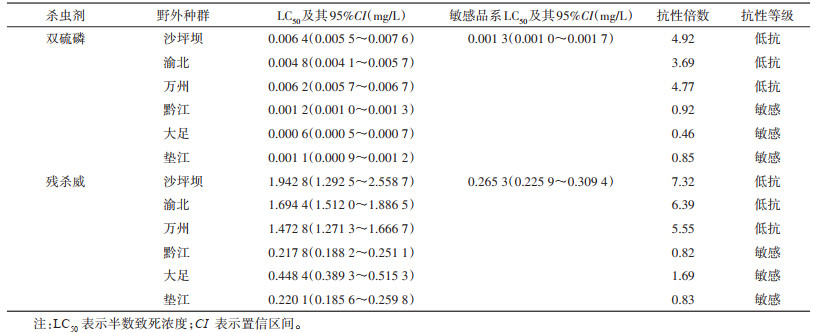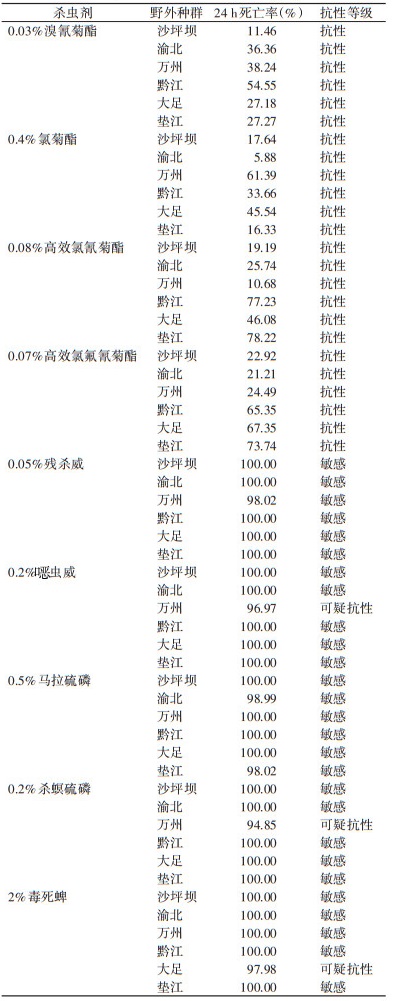扩展功能
文章信息
- 涂涛田, 肖汉森, 孟凤霞, 刘起勇, 刘小波, 何亚明, 季恒青
- TU Tao-tian, XIAO Han-sen, MENG Feng-xia, LIU Qi-yong, LIU Xiao-bo, HE Ya-ming, JI Heng-qing
- 重庆市2019年登革热暴发疫情应急控制后媒介伊蚊抗药性调查
- An investigation of the insecticide resistance of Aedes vector after emergency control of a dengue fever outbreak in Chongqing, China, 2019
- 中国媒介生物学及控制杂志, 2022, 33(1): 44-47
- Chin J Vector Biol & Control, 2022, 33(1): 44-47
- 10.11853/j.issn.1003.8280.2022.01.008
-
文章历史
- 收稿日期: 2021-10-12
2 中国疾病预防控制中心传染病预防控制所, 传染病预防控制国家重点实验室, 北京 102206
 虫威和杀螟硫磷产生可疑抗性及大足区野外白纹伊蚊成蚊对毒死蜱产生可疑抗性外,其余调查点野外白纹伊蚊成蚊对残杀威、
虫威和杀螟硫磷产生可疑抗性及大足区野外白纹伊蚊成蚊对毒死蜱产生可疑抗性外,其余调查点野外白纹伊蚊成蚊对残杀威、 虫威、马拉硫磷、杀螟硫磷、毒死蜱均为敏感。结论 重庆市各调查点白纹伊蚊成蚊对拟除虫菊酯类药物均产生抗性,部分调查点白纹伊蚊幼蚊对双硫磷和残杀威产生低抗。建议定期监测白纹伊蚊的抗性水平及变化趋势,根据不同虫态的抗药性采取相应的杀虫剂使用策略。
虫威、马拉硫磷、杀螟硫磷、毒死蜱均为敏感。结论 重庆市各调查点白纹伊蚊成蚊对拟除虫菊酯类药物均产生抗性,部分调查点白纹伊蚊幼蚊对双硫磷和残杀威产生低抗。建议定期监测白纹伊蚊的抗性水平及变化趋势,根据不同虫态的抗药性采取相应的杀虫剂使用策略。2 State Key Laboratory of Infectious Disease Prevention and Control, National Institute for Communicable Disease Control and Prevention, Chinese Centerfor Disease Control and Prevention, Beijing 102206, China
登革热是一种由登革病毒引起,经媒介伊蚊叮咬传播的蚊媒传染病,也是我国重要的法定乙类传染病,目前已分离出4个血清型的登革病毒,均有致病性。近年来,全球登革热疫情高发,引起全世界高度关注,危及30亿人健康安全,其传播媒介是埃及伊蚊(Aedes aegypti)和白纹伊蚊(Ae. albopictus)。近年来,我国登革热流行范围不断扩大,防控形势十分严峻[1]。2014年,我国广东、广西、福建和云南等南方省份暴发登革热疫情,仅广东省病例数就达4万多例[2],2019年重庆市首次出现登革热本地病例暴发疫情,全市报告登革热病例1 411例,位居全国第5位[3]。登革热目前没有特效的治疗方法,蚊媒防制是控制疫情最为关键的措施。控制蚊虫种群密度的方法中,化学防治起效较快且显著,但长期使用和滥用杀虫剂会产生抗药性[4]。为及时了解重庆市白纹伊蚊对常用卫生杀虫剂的敏感性,指导重庆市登革热防控及合理使用杀虫剂,2020年重庆市按照中国疾病预防控制中心(CDC)下发的《登革热媒介伊蚊专项调查方案》要求,选择2019年重庆市出现登革热本地疫情的万州、渝北和沙坪坝区以及未出现本地病例的黔江区、大足区和垫江县作为调查点,测定白纹伊蚊对常用卫生杀虫剂的敏感性,现将结果报告如下。
1 材料与方法 1.1 试虫野外白纹伊蚊种群,于2020年5-10月分别采集于万州、渝北、沙坪坝、黔江、大足和垫江区(县)的公园或废旧轮胎堆放处,带回实验室饲养1~2代;敏感品系白纹伊蚊,来自中国CDC传染病预防控制所媒介生物控制室,重庆市CDC昆虫饲养室长期饲养。
1.2 药剂87.4%双硫磷原药、95.95%残杀威原药、0.08%高效氯氰菊酯、0.03%溴氰菊酯、0.4%氯菊酯、0.07%高效氯氟氰菊酯、2%毒死蜱、0.5%马拉硫磷、0.2%杀螟硫磷、0.05%残杀威和0.2% 
以4龄初幼蚊为测试对象,用丙酮稀释原药,将待测药剂配制成5~7个系列浓度,即在250ml的烧杯中加入199.9 ml脱氯水和0.1 ml相应的药液,每个烧杯内加入20只试虫。每个梯度设3个重复。以丙酮为对照。试虫在(25±1)℃、相对湿度为(70±10)%、光照周期(L∶D)=14 h∶10 h的条件下,观察并记录各处理的死亡数。实验重复3次。死亡判断标准:用针尖触碰幼蚊,幼蚊无逃避反应视为死亡。
1.3.2 成蚊接触筒法[5]用吸蚊管取30只羽化3~5d未吸血健康雌蚊放入恢复筒中,平行放置15 min,剔除不健康蚊虫。在隔板另一面装上已衬贴药纸的接触筒,使恢复筒在下面,竖直放置,轻轻拍打使蚊虫聚集于恢复筒底部,然后瞬间把隔板抽开,互换接触筒与恢复筒位置,将恢复筒内蚊虫轻吹入接触筒,迅速关上隔板。将筒平放,即开始计算接触时间。接触药膜60 min后抽开隔板,将蚊虫吹至恢复筒内,关闭隔板,取下恢复筒直立放置并饲以8%葡萄糖水,恢复饲养24 h后观察死亡数,计算死亡率,实验重复3次,设对照组。试虫死亡的判断标准:试虫完全不动,或仅躯体、足、翅或触角等震颤而无存活的可能性,视为死亡。
1.4 抗性评价标准幼蚊:抗性倍数 < 3为敏感;3≤抗性倍数 < 10为低抗;10≤抗性倍数 < 40为中抗;抗性倍数≥40为高抗[6]。
成蚊:根据《蚊虫抗药性检测方法》(GB/T 26347-2010)中抗性判断标准,在诊断剂量下蚊虫的死亡率在≥98%表明其为敏感种群,在80%~98%(不含)表明其为可疑抗性种群,< 80%表明其为抗性种群。
1.5 统计分析采用SPSS 25.0软件计算半数致死浓度(LC50)和抗药性倍数。抗性倍数=野外种群蚊虫LC50/敏感品系蚊虫LC50。
2 结果 2.1 白纹伊蚊幼蚊对2种杀虫剂的敏感性重庆市万州、渝北和沙坪坝区野外白纹伊蚊幼蚊对双硫磷和残杀威呈现低抗水平,其余地区均显示为敏感。见表 1。

|
依据中国CDC传染病预防控制所建立的诊断剂量,重庆市各调查点白纹伊蚊成蚊对溴氰菊酯、氯菊酯、高效氯氰菊酯、高效氯氟氰菊酯均产生抗性,24 h死亡率在5.88%~78.22%;对残杀威和马拉硫磷均为敏感;对 

|
2019年重庆市首次出现登革热本地病例暴发疫情,在疫情处置中,有效的控制措施主要是快速降低传播媒介密度,卫生杀虫剂的使用不可或缺。随着杀虫剂的大量使用,部分地区蚊虫可能产生了抗药性。
本次白纹伊蚊幼蚊抗性监测选择的药物是双硫磷、残杀威,其中双硫磷是我国幼蚊防制常用药物之一[7]。监测结果显示,重庆市万州、渝北和沙坪坝区白纹伊蚊幼蚊对双硫磷和残杀威产生低抗,与2016年监测结果基本一致[8]。可能与白纹伊蚊幼蚊主要孳生在小型积水容器,在蚊虫防制时不易施药,幼蚊接触杀虫剂较少有关。拟除虫菊酯类药物具有高效、广谱、低毒、低残留等优点,被广泛应用于病媒生物的防治,是目前使用量较大、使用频率较高的杀虫剂。重庆市各调查点白纹伊蚊成蚊对溴氰菊酯、氯菊酯、高效氯氰菊酯、高效氯氟氰菊酯均产生抗性,与国内其他省市情况基本一致[9-11],分析原因可能与疫情控制及近些年卫生城市创建大量使用拟除虫菊酯类药物有关。除万州区白纹伊蚊成蚊对

监测结果提示,重庆市在今后的蚊虫防制工作中,应高度重视蚊虫孳生地治理,适时投放双硫磷等防制幼蚊药物,在成蚊防制中应减少使用已出现抗性的药物,尽量选择目前较为敏感或者仅产生可疑抗性的药物,如有机磷和氨基甲酸酯类药物,同时注意药物的轮换和交替使用,以延缓抗性产生及进一步发展。
利益冲突 无
| [1] |
Chen B, Liu QY. Dengue fever in China[J]. Lancet, 2015, 385(9978): 1621-1622. DOI:10.1016/S0140-6736(15)60793-0 |
| [2] |
Xiao JP, Liu T, Lin HL, et al. Weather variables and the El Niño Southern Oscillation may drive the epidemics of dengue in Guangdong province, China[J]. Sci Total Environ, 2018, 624: 926-934. DOI:10.1016/j.scitotenv.2017.12.200 |
| [3] |
刘起勇. 我国登革热流行新趋势、防控挑战及策略分析[J]. 中国媒介生物学及控制杂志, 2020, 31(1): 1-6. Liu QY. Dengue fever in China: new epidemical trend, challenges and strategies for prevention and control[J]. Chin J Vector Biol Control, 2020, 31(1): 1-6. DOI:10.11853/j.issn.1003.8280.2020.01.001 |
| [4] |
陆宝麟. 城市灭蚊[M]. 北京: 科学出版社, 1992: 97-103. Lu BL. Urban mosquito control[M]. Beijing: Science Press, 1992: 97-103. |
| [5] |
中华人民共和国卫生部. GB/T 26347-2010蚊虫抗药性检测方法生物测定法[S]. 北京: 中国标准出版社, 2011. Ministry of Health of the People's Republic of China. GB/T 26347-2010 Test methods of mosquito resistance to insecticides-Bioassay methods[S]. Beijing: Standards Press of China, 2011. (in Chinese) |
| [6] |
王义冠, 师灿南, 林国松, 等. 广东省潮州市白纹伊蚊对常用杀虫剂的抗药性[J]. 中国媒介生物学及控制杂志, 2016, 27(3): 228-231. Wang YG, Shi CN, Lin GS, et al. Resistance of Aedes albopictus in Chaozhou city, China to commonly used insecticides[J]. Chin J Vector Biol Control, 2016, 27(3): 228-231. DOI:10.11853/j.issn.1003.8280.2016.03.004 |
| [7] |
王以燕, 姜志宽. 我国公共卫生用农药的发展及应用概况[J]. 中国媒介生物学及控制杂志, 2016, 27(5): 421-425. Wang YY, Jiang ZK. Development and application of public health pesticides in China, 2013-2016[J]. Chin J Vector Biol Control, 2016, 27(5): 421-425. DOI:10.11853/j.issn.1003.8280.2016.05.001 |
| [8] |
涂涛田, 季恒青, 冯绍全, 等. 重庆市部分地区白纹伊蚊幼虫对4种杀虫剂的敏感性调查[J]. 中国媒介生物学及控制杂志, 2016, 27(5): 408-409. Tu TT, Ji HQ, Feng SQ, et al. A survey on susceptibility of Aedes albopictus larvae to four insecticides in some areas of Chongqing[J]. Chin J Vector Biol Control, 2016, 27(5): 408-409. DOI:10.11853/j.issn.1003.8280.2016.05.024 |
| [9] |
章灿明, 李玉伟, 陈斌, 等. 福建省2019年国家级监测点白纹伊蚊密度与抗药性监测分析[J]. 中国媒介生物学及控制杂志, 2021, 32(1): 65-69. Zhang CM, Li YW, Chen B, et al. An analysis of the surveillance data on density and insecticide resistance of Aedes albopictus in three national surveillance sites in Fujian province, China, 2019[J]. Chin J Vector Biol Control, 2021, 32(1): 65-69. DOI:10.11853/j.issn.1003.8280.2021.01.013 |
| [10] |
叶兵, 段金花, 秦冰, 等. 广东省登革热媒介白纹伊蚊成蚊抗药性水平的调查及防控[J]. 热带医学杂志, 2020, 20(8): 1098-1101. Ye B, Duan JH, Qin B, et al. Resistance of adult Aedes albopictus to insecticides and prevention measures of Guangdong province[J]. J Trop Med, 2020, 20(8): 1098-1101. DOI:10.3969/j.issn.1672-3619.2020.08.027 |
| [11] |
王丹, 史鹏, 赵文平, 等. 贵州省兴义及赤水市白纹伊蚊抗药性监测分析[J]. 中国媒介生物学及控制杂志, 2021, 32(3): 302-306. Wang D, Shi P, Zhao WP, et al. Monitoring and analysis of insecticide resistance of Aedes albopictus in Xingyi and Chishui cities of Guizhou province, China[J]. Chin J Vector Biol Control, 2021, 32(3): 302-306. DOI:10.11853/j.issn.1003.8280.2021.03.009 |
| [12] |
赵春春, 朱彩英, 贾清臣, 等. 2017-2018年我国不同区域白纹伊蚊对常用杀虫剂的抗药性[J]. 中国媒介生物学及控制杂志, 2020, 31(2): 126-132. Zhao CC, Zhu CY, Jia QC, et al. Resistance of Aedes albopictus to commonly used insecticides in different areas of China, 2017-2018[J]. Chin J Vector Biol Control, 2020, 31(2): 126-132. DOI:10.11853/j.issn.1003.8280.2020.02.002 |
 2022, Vol. 33
2022, Vol. 33


